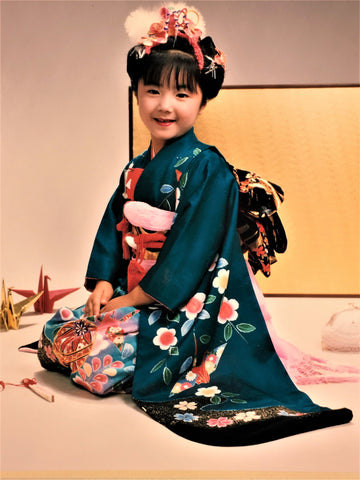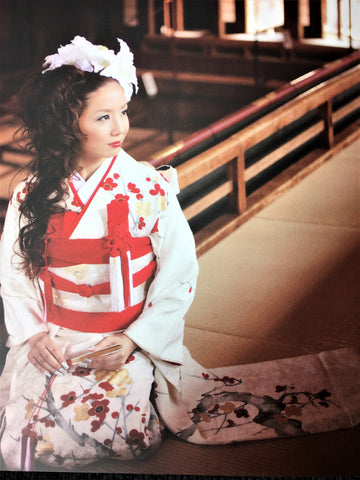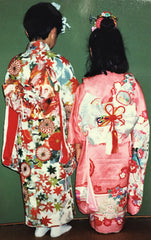


We recently came across some pictures of Yoko's niece Ai (kanji is for 'love') when she was seven years old at Shichi-Go-San time and a picture from her wedding photo album years later. It struck us that the traditional use of kimonos in Japan had bookmarked her life's key moments. We'd like to share them here:
Celebrating Childhood Kimonos:


Shichi-Go-San is celebrated when children are ages 3, 5 and 7 (though it's said 7-5-3 in Japanese). Special ceremonial kimonos for boys and girls are worn for a visit to the neighborhood Shinto shrine.This practice is centuries old. There is a great wikipedia page about this cultural practice HERE.

New Year's Girls Kimonos



Coming of Age Kimonos:
Seijin no Hi

There is also the coming of age (20) celebration for young women called Coming of Age Day (成人の日 Seijin no Hi) which takes place every second Monday in January; this practice is also marked by splendid kimonos worn on that day when they celebrate their entry into adulthood. Details about Seijin no Hi HERE.

Marriage Ceremony Kimonos:

As for how kimonos mark important life events, the case of weddings is especially interesting. The practice in Japan these days is often to combine having a Shinto religious wedding followed by a more Western style (but done decidedly in Japanese style) celebration and then a wedding banquet where all parties wear the type kimonos tradition requires, based on gender, age, whether single or married and other status factors.
The bride may start the wedding day wearing a highly formal white shiromuku kimono for the Shinto ceremony and/or later also the most formal uchikake (highly ornate) kimonos. In our niece Ai's case (above) she wore a gorgeous long-train white wedding dress at first during the church wedding ceremony but also wore a special furisode (long sleeves as shown in picture above) at times during the day of the wedding celebration.
Nowadays, given the high cost of the ceremonial wedding uchikake and furisode for example, some families need to rent them out. By any measure, today's Japanese weddings are typically over-the-top productions, with the only limit being the income of the family paying for the big day.
The blending of the traditional kimonos and modern dress is fascinating (for the non-Japanese observer perhaps). We have ourselves also been to Japanese weddings which skipped the Shinto (and shiromuku) shrine wedding and have instead a christian (or Catholic) wedding much as one sees in the West; but even in that case during the wedding banquet the bride appears in the uchikake and/or other high-end furisode, only to sometimes later show up on the dance floor in ball gown or a mini-skirt. This melange of traditional with contemporary makes for quite a splendid celebration and a visual treat given all the textile art being worn.
In conclusion then, we see kimonos as markers for stages in a Japanese woman's life, from childhood to adulthood to marriage, and even to one's final appearance at one's own funeral ( But that's a topic for another time).
